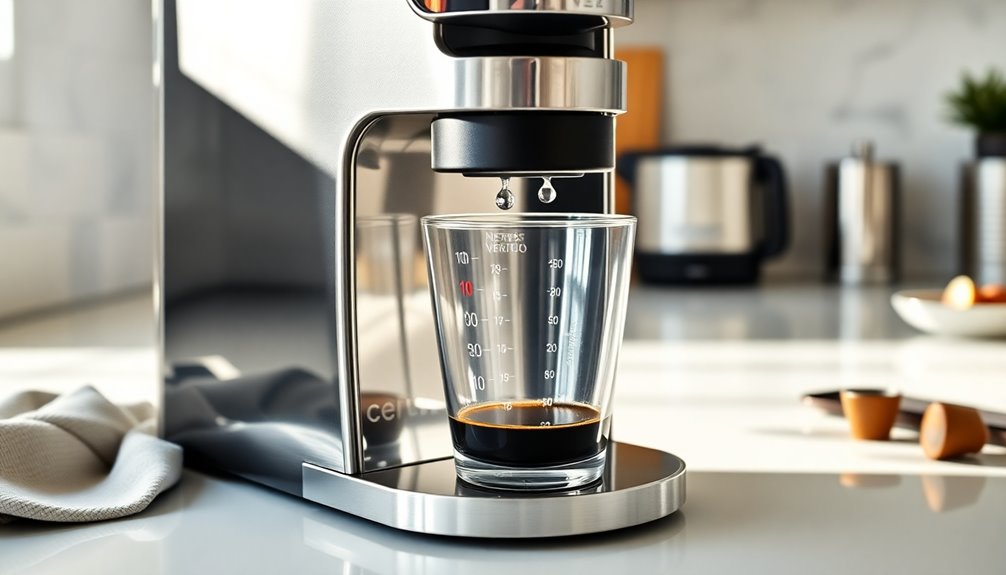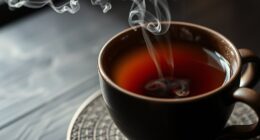One common mistake is using the wrong grind size, which can make your coffee bitter or bitter from over- or under-extraction. Make sure you measure your coffee-to-water ratio accurately and adjust your grind and brew time as needed. Using water that’s too hot or cold impacts flavor, so keep it between 195°F and 205°F. Don’t forget to store coffee properly and clean your equipment regularly. Keep experimenting; there’s more to learn for perfect brew.
Key Takeaways
- Use water at the correct temperature (195°F–205°F) to prevent over- or under-extraction and ensure balanced flavor.
- Store coffee properly in airtight, opaque containers away from heat and light to maintain freshness and prevent staling.
- Always pre-wet or bloom coffee grounds to release gases and promote even extraction, enhancing aroma and flavor complexity.
- Keep brewing equipment clean through regular rinsing and descaling to avoid residual oils that cause bitterness and impair taste.
- Measure coffee and water precisely, and use timers to control brew time for consistent extraction and optimal flavor.
Using the Wrong Coffee Grind Size

Using the wrong coffee grind size is one of the most common mistakes that can ruin your brew. Choosing the right grind size depends on your brewing method, so it’s essential to contemplate grind size selection carefully. Too fine, and you might end up with over-extraction, resulting in a bitter taste. Too coarse, and your coffee could be under-extracted, leaving it weak and sour. Consistency in grinding is vital—you want uniform particles to guarantee even extraction. Invest in a good burr grinder instead of blade grinders, which often produce uneven grounds. Regularly check and adjust your grind size as needed, especially if you notice changes in flavor or brewing time. Proper grind size plays a crucial role in achieving the perfect cup, so paying attention to this detail can significantly improve your coffee experience. Maintaining a consistent grind size is also essential for optimal extraction, which directly influences flavor clarity. Mastering grind size selection and maintaining consistency will markedly improve your coffee’s flavor and overall quality.
Incorrect Coffee-to-Water Ratio

Getting the right coffee-to-water ratio is vital for a great brew. If you use too much or too little coffee, your drink can taste weak or bitter. Adjust the amount to match your taste preferences for the perfect cup. Proper measurement of ingredients is also essential to achieve consistent results. Using an appropriate brewing ratio ensures optimal extraction and flavor balance. Additionally, understanding how different brewing methods impact the ideal ratio can help you tailor your coffee to your liking. For example, certain tuning techniques in vehicle modifications demonstrate the importance of precise adjustments for optimal performance, much like perfecting your coffee ratio.
Precise Measurement Matters
If your coffee tastes weak or overly bitter, the problem often lies in the coffee-to-water ratio. Precision brewing relies on accurate measurement to guarantee consistency and perfect flavor. Using too much coffee results in a strong, bitter brew, while too little creates a weak, insipid cup. To achieve the right balance, invest in a scale and measure your coffee and water precisely. This simple step helps eliminate guesswork and maintains the ideal ratio every time. Remember, even small deviations can considerably impact taste. By focusing on accurate measurement, you control the strength and flavor profile of your coffee, making each cup reliably delicious. Additionally, understanding the importance of the coffee-to-water ratio can help you fine-tune your brewing process for optimal taste. Paying attention to brew temperature ensures proper extraction and enhances overall flavor, further elevating your coffee experience. Properly grinding coffee also plays a crucial role in achieving the perfect brew, as inconsistent grind size can lead to over-extraction or under-extraction, affecting flavor and strength.
Furthermore, maintaining consistent brewing techniques can help develop a routine that consistently produces great coffee.
Adjust to Taste
Even with precise measurements, your personal taste can vary, making it important to adjust the coffee-to-water ratio to suit your preferences. This step allows for flavor customization and guarantees your coffee isn’t too weak or too strong. If your brew tastes too bitter or intense, try reducing the coffee amount slightly. Conversely, if it’s too weak or lacking flavor, increase the coffee-to-water ratio. Experimentation helps you find the perfect balance, enhancing your overall experience. Remember, strength balancing is key—your ideal cup depends on your taste, not just standard measurements. Don’t be afraid to make small adjustments until you achieve the flavor profile you love. By tuning the ratio, you can craft a cup that’s perfectly tailored to your preferences every time. Incorporating layering textures through different brewing methods can further elevate your coffee experience. Understanding brewing techniques can also help you refine your process for even better results. Additionally, paying attention to essential oils that enhance aroma and flavor can add a subtle complexity to your brew. Exploring different juice varieties and their unique characteristics can inspire new ways to enjoy your brew, whether through infused flavors or pairing suggestions. Regularly exploring different coffee concentrations can also uncover new flavor dimensions and deepen your appreciation for the craft.
Over- or Under-Extracting Coffee
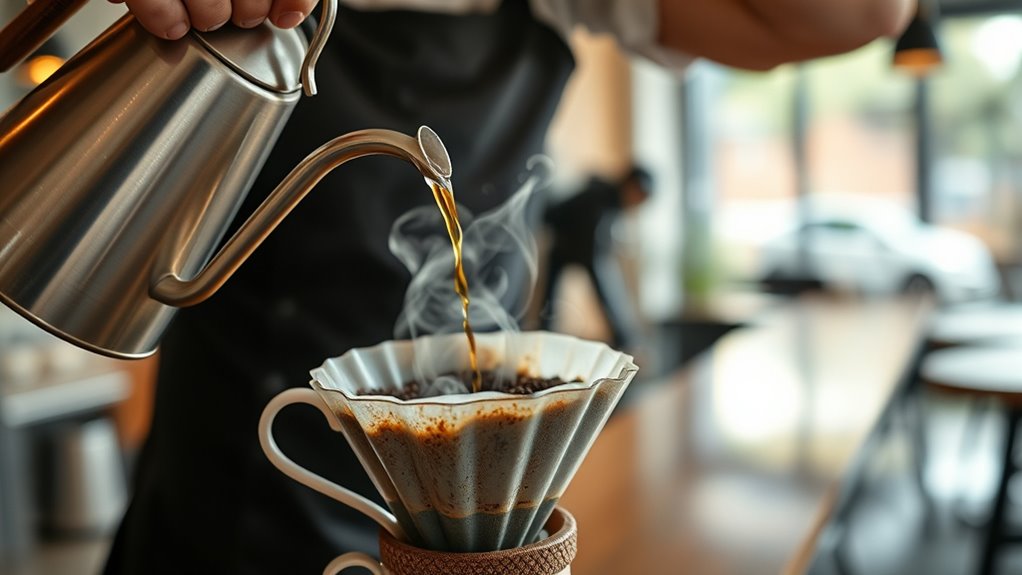
If your coffee tastes off, it might be over- or under-extracted. To fix this, try adjusting your grind size and tweaking your brew time. Also, make sure you’re using the right temperature to bring out the best flavor. Understanding proper extraction techniques can help you achieve a balanced brew every time. Additionally, paying attention to headphone compatibility with your brewing setup can enhance your overall coffee experience, especially if you listen to music or podcasts while brewing. Incorporating somatic awareness into your brewing process can also help you develop a more mindful and precise approach to your coffee making. Being aware of your dog breeds can also influence how you approach activities related to brewing, such as transporting equipment or exploring different brewing locations.
Adjust Grind Size
Have you ever noticed your coffee tasting too bitter or too weak? Adjusting your grind size can fix this. If your coffee is over-extracted, try a coarser grind to slow extraction. If it’s under-extracted and weak, go finer to increase extraction. Proper grind calibration ensures grind consistency, which is essential for even extraction. Small changes can make a big difference in flavor.
- Use a consistent grind size for uniform extraction
- Adjust grind size in small increments
- Calibrate your grinder regularly for grind consistency
- Avoid overly fine or coarse settings initially
- Experiment with different grind levels to find the sweet spot
Tweak Brew Time
Adjusting your brew time is a straightforward way to correct over- or under-extraction and improve flavor. If your coffee tastes dull or sour, try a brew time adjustment: increasing it can enhance flavor extraction, making the brew richer and more balanced. Conversely, if your coffee is overly bitter or harsh, shortening the brew time can prevent over-extraction. Consistency is key—small tweaks can make a big difference. Use a timer to track your brewing process and experiment with slight adjustments until you find the ideal duration for your method. Remember, the right brew time guarantees proper flavor extraction, highlighting the coffee’s nuanced qualities without bitterness or sourness. Fine-tuning this step is vital for achieving a well-balanced, flavorful cup. Proper exfoliation with glycolic acid can also improve your skin’s appearance, making it smoother and more radiant. Additionally, understanding the science of extraction can help you optimize your brewing process for the best possible taste, especially when combined with knowledge of natural elements that influence flavor.
Use Correct Temperature
Using the correct temperature is essential to prevent over- or under-extraction, which can dramatically affect your coffee’s flavor. Water temperature impacts brewing consistency, ensuring all flavors are properly extracted without bitterness or sourness. Too hot, and you risk over-extraction, making your coffee bitter; too cold, and under-extraction leaves it sour and weak. Aim for a water temperature between 195°F and 205°F for ideal results. Consistent temperatures help maintain uniform extraction, giving you a balanced cup. Adjust your brewing method if your coffee tastes off, and use a thermometer if needed. Proper water temperature ensures your coffee’s flavors develop fully, avoiding common mistakes that compromise taste. Regularly monitoring your brewing temperature can help prevent ineffective purification, ensuring a better overall coffee experience.
Using Water That Is Too Hot or Too Cold

Water temperature plays a crucial role in extracting the best flavors from your coffee, but when it’s too hot or too cold, your brew can suffer. Using water that’s too hot can over-extract bitter compounds, making your coffee harsh and unpleasant. Conversely, water that’s too cold won’t extract enough flavor, resulting in weak, underwhelming coffee. Maintaining proper water temperature ensures brewing consistency, so each cup delivers balanced flavors. Aim for around 195°F to 205°F (90°C to 96°C) for ideal results. Using inconsistent water temperatures can lead to unpredictable taste and weakens your skill. Invest in a thermometer or a kettle with temperature control to help you hit the right mark. Consistent water temperature is key to flavor extraction achieving a flavorful, well-balanced brew every time. Temperature control devices help ensure your water stays within the optimal range for perfect coffee extraction.
Neglecting Proper Coffee Storage
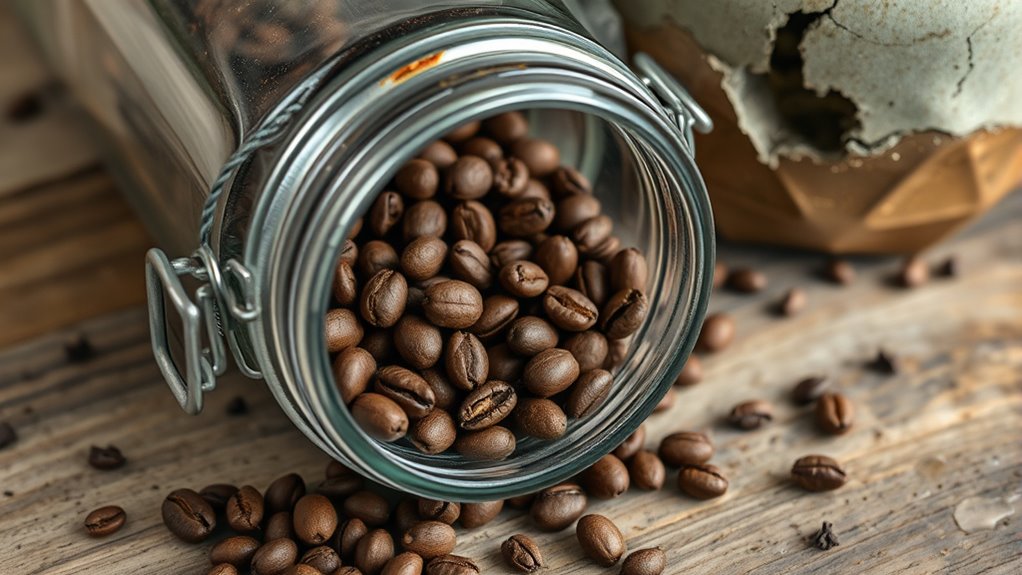
Neglecting proper coffee storage can quickly diminish the freshness and flavor of your brew. If you don’t store your coffee correctly, it’s exposed to air, moisture, and light, which accelerate staling. To keep your coffee fresh, choose a suitable coffee container that blocks light and seals tightly. Pay attention to storage conditions: keep your coffee in a cool, dark place away from heat and humidity. Avoid storing it in the fridge or freezer long-term, as moisture can damage beans. Proper storage helps preserve aroma and flavor, ensuring every cup tastes as fresh as possible.
- Use an airtight, opaque coffee container
- Store in a cool, dark environment
- Keep away from sunlight and heat sources
- Avoid storing near spices or strong-smelling foods
- Don’t refrigerate or freeze beans long-term
Skipping the Pre-Wetting or Blooming Process

Skipping the pre-wetting or blooming process can lead to a dull and uneven extraction, causing your coffee to lack depth and aroma. When you skip this step, you interfere with water absorption, which is essential for revealing the coffee’s full flavor potential. Blooming allows gases trapped in the coffee grounds to escape, promoting better extraction and more consistent flavor development. Without it, the water may channel through the grounds unevenly, resulting in weak or sour notes. By properly blooming your coffee, you give the grounds time to release CO₂, ensuring the water interacts evenly and extracts the rich oils and compounds that create complexity in your cup. Don’t overlook this step—it’s key to achieving a vibrant, well-balanced brew with enhanced aroma and flavor.
Ignoring Equipment Cleanliness
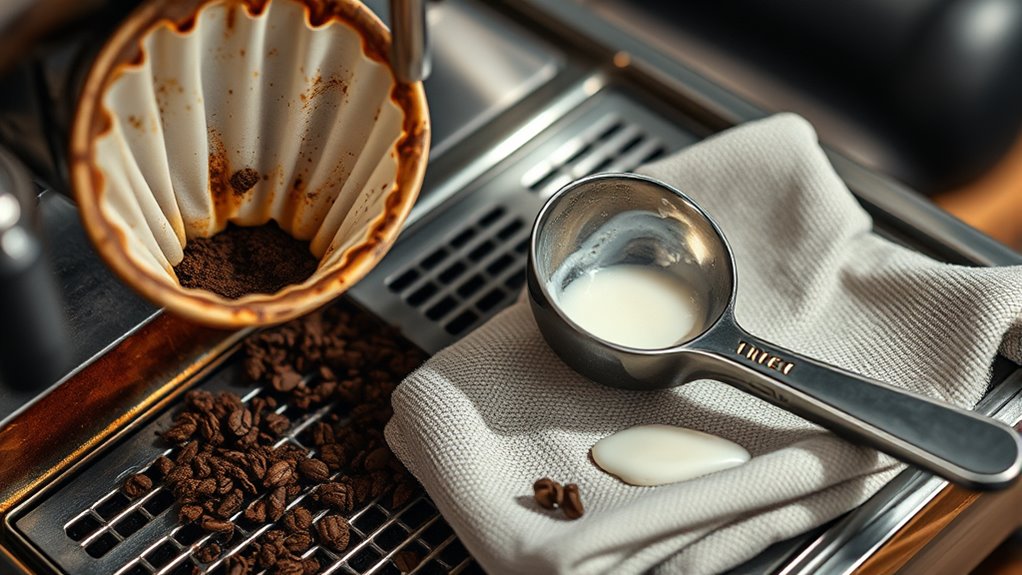
When equipment isn’t thoroughly cleaned, residual oils, coffee grounds, and mineral buildup can quickly accumulate, negatively impacting the flavor of your brew. Neglecting proper equipment maintenance and skipping cleaning routines can lead to bitter tastes and clogged filters. Regular cleaning guarantees your coffee tastes fresh and consistent.
- Rinse out your coffee maker daily
- Descale equipment weekly or as needed
- Clean coffee filters and carafes thoroughly
- Wipe down portafilters and grinders
- Avoid using harsh chemicals that can leave residues
Rushing the Brew Time

Rushing the brew time can substantially impair the quality of your coffee. When you hurriedly extract, you sacrifice brew time consistency, which is vital for maximum flavor. Inaccurate timing can cause under-extraction, resulting in weak, sour coffee, or over-extraction, making it bitter and harsh. To fix this, use a timer to track your brew duration precisely, guaranteeing you stick to the recommended timing for your method. Consistent brew times help develop a reliable routine, so each cup turns out balanced and flavorful. Avoid rushing through the process; patience ensures proper extraction. Remember, accurate timing isn’t just about speed—it’s about precision. By paying attention to your brew time accuracy, you’ll improve your overall coffee quality with every cup.
Frequently Asked Questions
How Can I Tell if My Coffee Grind Size Is Correct?
To tell if your coffee grind size is correct, pay attention to the grind consistency; it should be uniform without too many fine or coarse particles. Use a brewing scale to measure your coffee grounds, ensuring you’re using the right amount for your brewing method. If your coffee tastes weak or over-extracted, adjust the grind size accordingly—finer for a stronger brew, coarser for a smoother one.
What’S the Ideal Coffee-To-Water Ratio for Different Brewing Methods?
Sure, finding the perfect brew ratio might seem tricky, but it’s just about balancing extraction. For drip coffee, aim for about 1:15, while espresso prefers 1:2. French press works well with 1:12. This ideal brew ratio ensures you don’t under- or over-extract, giving you that ultimate flavor. Remember, adjusting your brew ratio fine-tunes the extraction balance, so experiment until your coffee hits that sweet spot.
How Do I Prevent Over-Extraction or Under-Extraction?
To prevent over- or under-extraction, pay attention to your brew time and water quality. If your coffee tastes bitter or too strong, reduce the brew time or grind finer. If it’s weak or sour, extend the brew time or grind coarser. Use clean, filtered water to guarantee ideal extraction. Adjust these factors gradually, tasting as you go, to find the perfect balance for your preferred flavor.
What Is the Proper Water Temperature for Brewing Coffee?
They say, “the devil is in the details,” and that’s true for brewing coffee. The proper water temperature for brewing coffee is between 195°F and 205°F. This range helps you achieve brewing consistency, ensuring your coffee isn’t too bitter or weak. If your water’s too hot, you risk over-extraction; too cold, and it’s under-extracted. Use a thermometer to keep your water exactly where it needs to be.
How Often Should I Clean My Coffee Equipment?
You should clean your coffee equipment regularly to guarantee great-tasting brews. Follow a cleaning schedule of at least once a month, or more often if you use hard water. Descaling tips include using vinegar or descaling solutions to prevent mineral buildup. Regular cleaning removes residue, oils, and scale, keeping your machine in top shape and extending its lifespan. Staying consistent with cleaning helps you enjoy fresh, flavorful coffee every time.
Conclusion
Did you know that fixing just a few common brewing mistakes can transform your coffee experience? It’s true—small tweaks like adjusting grind size or water temperature make a huge difference. Some say brewing is an art, but science proves that attention to detail boosts flavor. So, next time you brew, consider these tips; your perfect cup might just be a mistake away. Coffee mastery is within your reach—just brew smarter!




